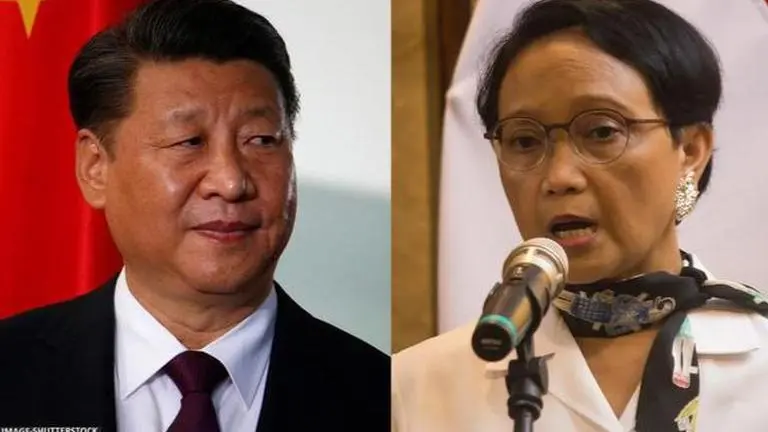Updated 1 September 2023 at 12:58 IST
Indonesia turns fifth nation to question China's map after Philippines, Vietnam, Malaysia
Indonesia reiterated that it has always consistently held its positions about its sovereign claims. "Indonesia's position is not new," said Marsudi.
- World News
- 5 min read

Indonesia's Foreign Minister Retno Marsudi on Thursday, August 31 questioned China's unilaterally drafted official 'standard map' that shows the sovereign Indian territories as its own. Beijing's official Standard Map Edition 2023 depicts the Aksai Chin plateau as part of Hotan County and the Indian state of Arunachal Pradesh within the Chinese territory as part of Tibet. The map also lays sovereign claims in the contentious South China Sea near the southern region comprising Indonesia’s Natuna Islands.
Indonesian Foreign Minister Marsudi insisted that China must release the map marking its territorial lines strictly in accordance with the UN Convention on the Law of the Sea 1982 (UNCLOS 1982). China's distorted map, which has sparked a furore among the neighbouring countries, depicts Malaysian waters and some of the regions that fall under the sovereign control of Indonesia as its own. Apart from projecting the Aksai China plateau in the Western Himalayas as Chinese territory, the map also renamed at least 11 places in the Arunachal Pradesh state that it shows fall in “Zangnan” or southern Tibet in Chinese.
The littoral states in the disputed South China Sea protest China's so-called nine-dashed line in the maritime region that consists of 12 per cent of the world’s total fish and felicitates approximately one-third of all global maritime trade.
In its new map China, for the first time, has included the 10th dash as its ‘International Border.' This includes the exclusive economic zones (EEZ) of other coastal states such as the Philippines. The updated version of the map shows China's version of its sovereign territories forming a U shape that includes the entire South China Sea, Taiwan, EEZ Philippines near Sabah and Sarawak, Malaysia, Brunei, Vietnam, and Indonesia.
Advertisement
China's new '10-dash' line map. Credit: China's Ministry of Natural Resources.
The Chinese fishing trawlers and boats regularly traverse the contested South China Sea to exploit natural resources off their shores, like fish or natural gas, sparking anger among the smaller island nations of Vietnam, the Philippines and Malaysia. On Friday, Indonesian Foreign Minister Marsudi said that Jakarta will lodge a protest against China about its claim on the South China Sea as outlined in the new map published by the Ministry of Natural Resources of China.
Advertisement
"Any drawing of lines, any claims made must be in accordance with UNCLOS 1982," Marsudi reportedly said, after a working meeting with Commission I of the DPR RI at the Parlemen Complex, Senayan, Jakarta.
The Foreign Minister of Indonesia reiterated that Indonesia has always consistently held its positions about its sovereign claims. "Indonesia's position is not a new position, but a position that has always been presented consistently," said Marsudi. Chinese Foreign Ministry Spokesperson Wang Wenbin meanwhile a day earlier said that he hopes that countries will not "over-interpret the new map."
"We hope that the relevant parties can remain objective and calm, and refrain from interpreting this problem excessively," said Wang Wenbin in a statement.
China's structure on the man-made Fiery Cross Reef on the disputed Spartleys Islands. Credit: AP
'We reject these claims as they have no basis': India's FM spokesperson
India’s foreign ministry spokesman Arindam Bagchi said in a statement slammed the distorted representation of the areas on China's map. "We have today lodged a strong protest through diplomatic channels with the Chinese side on the so-called 2023 ‘standard map’ of China that lays claim to India’s territory," Bagchi stated. “We reject these claims as they have no basis. Such steps by the Chinese side only complicate the resolution of the boundary question,” he went on to add.
China's delusional map was also criticised by Filipino Foreign Affairs Spokesperson Ma. Teresita Daza. "This latest attempt to legitimise China’s purported sovereignty and jurisdiction over Philippine features and maritime zones has no basis under international law, particularly the 1982 United Nations Convention on the Law of the Sea (UNCLOS)," said Daza.
Maritime areas of the South China Sea "encompassed by the relevant part of the ‘nine-dash line’ are contrary to the Convention and without lawful effect to the extent that they exceed the geographic and substantive limits of China’s maritime entitlements under the Convention,” she added. Philippines, therefore," calls on China to act responsibly and abide by its obligations under UNCLOS and the final and binding 2016 Arbitral Award."
Vietnamese Ministry of Foreign Affairs, meanwhile voiced its "consistent stance" on the sovereignty over Hoang Sa (Paracel) and Truong Sa (Spratly). It resolutely rejected "any maritime claims of China that are based on the nine-dash line in the East Sea." Malaysian Foreign Minister Dr Zambry Abdul Kadir also slammed China's geopolitical shams, saying that this has been "our practice (when dealing with issues like this)... and based on the statement issued by Wisma Putra yesterday, the next step includes sending a protest note." Spokesperson of Taiwan's Ministry of Foreign Affairs, Jeff Liu, asserted that the island nation is a "sovereign and independent country that is not subordinate to the People's Republic of China."
On Thursday, the militaries of Indonesia and five other nations began annual training exercises on Indonesia’s main island of Java led by the US military in a defiance posture against the People's Republic of China. The latter sees the drills as a regional threat and has compared the US alliances in the Indi-Pacific to NATO.
Published By : Zaini Majeed
Published On: 1 September 2023 at 12:42 IST


